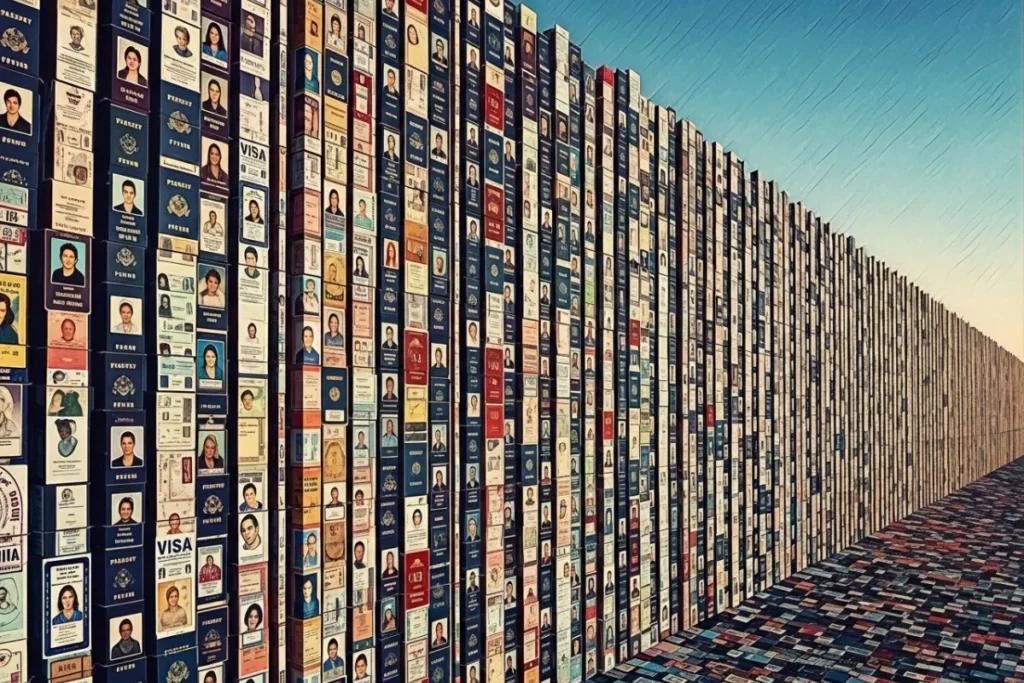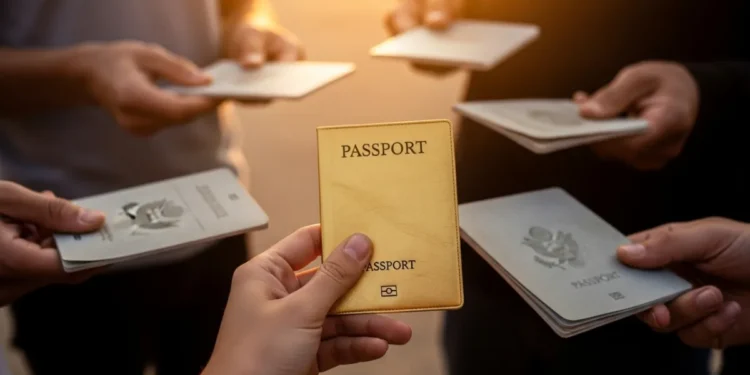Explore the evolution of freedom of movement, its implications in human rights, and the impact of passports on global mobility. This blog post delves into the historical context of passports, current travel restrictions, and the disparities in passport power. It discusses how globalization influences movement and highlights advocacy efforts for more equal access to travel rights. Understand the role of technology in shaping modern passports and envision a future where freedom of movement is a universal right rather than a privilege limited by nationality or economic status.
Table of Contents
Introduction to Freedom of Movement
Freedom of movement is a fundamental human right recognized in various international treaties and declarations (Universal Declaration of Human Rights, Article 13). It embodies the idea that every individual should have the ability to move freely within their country and across borders, facilitating personal growth, economic opportunities, and cultural exchange. The significance of this right can be traced back to the emergence of human civilization, where migration played a pivotal role in the development of societies and the exchange of ideas.
Throughout history, the concept of movement has evolved, often reflecting societal changes and political landscapes. In ancient times, nomadic tribes roamed vast territories, with little hindrance to their mobility. However, the advent of nation-states marked a substantial shift; governments began implementing borders and regulations to control movement, often citing security and economic stability as justifications for these restrictions. Consequently, as borders were established, the distinction between populations became more pronounced, making the right to move an increasingly privileged aspect of citizenship.
The emergence of modern passports in the 19th century represents a critical development in the regulation of freedom of movement. Initially introduced as a means to enhance security during an era of burgeoning nation-states, passports have since evolved into essential documents that dictate an individual’s right to traverse international boundaries. While intended to facilitate travel, these documents have also served to reinforce inequalities related to nationality and class. The implications of requiring passports for international movement are profound, as they create barriers that often restrict the mobility of certain groups, limiting their access to opportunities and rights.
The discussion surrounding freedom of movement today continues to be relevant as globalization expands and migration patterns shift. Understanding the historical and current context of this right is crucial in addressing contemporary challenges related to movement, ensuring that all individuals have equitable access to the world beyond their borders.
Historical Evolution of Passports
The concept of passports can be traced back to ancient civilizations where documents were used to facilitate safe passage through various territories. In the Persian Empire, for example, the use of written orders from a king served as a form of credentials that travelers could present, ensuring their protection while journeying across vast lands. Similarly, documentation resembling early passports emerged in ancient Rome, where citizens would carry akta, allowing them access to different regions of the empire. These early forms primarily served to provide recognition and protection, rather than regulate movement.
As we move into the Middle Ages, religious authorities commonly issued letters of safe conduct, granting individuals the right to travel across territories under their jurisdiction. It was during this period that the notion of control began to take shape, as rulers sought measures to regulate the movement of people, particularly as trade and commerce expanded. By the 19th century, as modern nation-states began to emerge, the structure of passports evolved significantly. Countries necessitated passports to identify travelers, and governments increasingly used them to control immigration, reflecting an increasing concern for security and sovereignty.
The pivotal moment for modern passports occurred around the time of World War I when nations recognized the need for standardized documentation to verify identities and manage borders effectively. This period marked a transition from informal travel permits to formally issued passports, which included personal details and even photographs. The main purpose of passports began to shift from merely facilitating travel to becoming essential tools for regulating human movement across borders. Today, passports are indispensable for international travel, symbolizing both the freedom of movement and the limitations imposed by national sovereignty.

Passports and National Sovereignty
The institution of passports is deeply intertwined with the concept of national sovereignty. A passport serves not only as a travel document but also as a symbol of a country’s authority over its borders. By issuing passports, nations determine who has the right to enter or exit their territory, effectively exercising control over the movement of individuals. This control is rooted in the principle of territorial integrity, a pillar of international law that upholds a state’s right to govern its land and defend its population.
The implications of passport control extend beyond mere border security; it also influences international relations and diplomacy. Countries often use their passport policies as leverage in diplomatic negotiations, impacting international travel agreements and visa provisions. For instance, a country may facilitate easier access to its territory for foreign nationals from strategic partner states, thereby strengthening bilateral relations. Conversely, restrictive passport policies can sour diplomatic relations and lead to tensions, particularly when one nation disputes another’s control over its citizens.
Citizenship, upon which the validity of a passport is predicated, further complicates this relationship. The possession of a passport signifies a formal recognition of citizenship, bestowing rights and privileges, including the freedom of movement. However, the criteria for obtaining a passport can vary significantly across different nations, often reflecting socio-political landscapes. Countries may impose stringent requirements that reinforce their sovereignty while also affecting marginalized groups or individuals in political turmoil. As a result, passport ownership can become a privilege that is not equally accessible to all individuals, raising questions about fairness and equality in the global landscape.
The Role of Technology in Modern Passports
The evolution of technology has significantly transformed the landscape of passport creation and management, leading to enhancements that affect both security and individual freedom of movement. One such advancement is the introduction of biometric passports, commonly referred to as e-passports. These modern passports are embedded with electronic chips that store personal data, including the passport holder’s fingerprints, photograph, and other identifying features. This biometric technology dramatically improves the accuracy of identity verification at immigration checkpoints, combating identity fraud and enhancing overall security measures. The increased reliance on biometric data allows for efficient processing times, thereby streamlining the immigration process for travelers.
Furthermore, digital identification systems have emerged as vital components of modern border control processes. Various countries have begun implementing mobile passport applications that enable travelers to store and manage their passport data digitally. These technologies not only reduce the physical footprint of traditional documentation but also facilitate quicker access to essential information during international travel. However, the shift towards digital identification raises pertinent questions regarding privacy and data protection. The aggregation of sensitive personal information in electronic databases creates vulnerabilities; unauthorized access or data breaches can jeopardize the security and privacy of individuals.
Moreover, while technological advancements in passport systems improve efficiency and security for travelers, they also present new challenges. The balance between enhanced security measures and the preservation of personal freedoms is an ongoing debate in the context of modern migration. Increased surveillance capabilities enabled by technology might infringe upon individual rights, raising concerns about overreach and the potential for discriminatory practices. Thus, as technology continues to reshape the passport landscape, it becomes imperative to navigate the dual objectives of securing borders and upholding personal freedoms judiciously.

Inequities in Passport Power
The disparities in passport power are stark reflections of global inequities related to mobility and privilege. Passport rankings, which are determined by the number of countries to which holders can travel without a visa, unveil a significant divide between nations. For instance, passports from countries such as Japan, Singapore, and Germany grant their holders access to over 190 destinations visa-free, while citizens from nations like Afghanistan or Syria face stringent travel restrictions, with access to fewer than 30 countries. This discrepancy illustrates not only the privilege afforded to specific nations but also how that privilege can consolidate power on a global scale.
The implications of these inequities extend beyond leisure travel. For many refugees and migrants, the limitations posed by their passports can severely restrict their opportunities for resettlement, employment, and education. Individuals from nations with weaker passports often face barriers in trying to escape conflict or pursue better living conditions, thus illustrating how passport power can perpetuate cycles of disadvantage. This structural inequity also undermines the concept of global citizenship, where the right to move freely should not be contingent upon the passport one holds.
Moreover, the disparities in passport power can exacerbate existing geopolitical tensions and exacerbate humanitarian crises. Countries with weaker passports may struggle to secure favorable immigration policies from more powerful nations, leaving individuals caught in precarious situations without recourse. The resulting landscape reveals a troubling narrative where mobility is dictated not by individual merit or humanitarian needs, but rather by the diplomatic standing of one’s nation. In a world increasingly defined by borders and nationality, the inequities in passport power serve as a reminder of the ongoing struggle for equitable access to global mobility.
The Impact of Globalization on Movement
The phenomenon of globalization has reshaped the way individuals and goods traverse international borders, fundamentally altering the landscape of movement. Although globalization has facilitated increased interconnectedness and economic opportunities across nations, this expansion has simultaneously led to the reinforcement of border controls and migration policies in an attempt to preserve national sovereignty. Consequently, while the demand for international travel and migration continues to rise, the freedom of movement for individuals has become a privilege often restricted by stringent regulations.
The past few decades have witnessed a surge in global economic activities, which has heightened the necessity for individuals to travel for work-related opportunities. Professionals and laborers alike are seeking careers that transcend national boundaries, leading to a demand for easier access to foreign job markets. However, despite the push for increased mobility, many countries have implemented stricter immigration policies. These regulations can create barriers that inhibit the very movement that globalization ostensibly promotes. Such tensions manifest in the form of lengthy visa processes, quotas on migrants, and additional security measures at borders.
This paradox highlights a fundamental issue within the context of modern globalized society. On one hand, the economic framework relies heavily on the mobility of talent and resources to drive growth; on the other hand, the reluctance of nations to fully embrace openness at their borders reflects deeper concerns regarding security, labor market impacts, and cultural integration. Thus, while globalization ideally suggests a more fluid exchange of people and ideas across countries, the reality often contradicts this vision, making the freedom of movement increasingly exclusive. The evolving nature of border policies represents a significant aspect of the ongoing discourse surrounding globalization and its implications for personal mobility.

Case Studies of Travel Restrictions
Travel restrictions have become an increasingly significant global issue, affecting many lives in profound ways. One prominent example is the plight of refugees fleeing conflict and persecution. According to the United Nations, there are over 26 million refugees worldwide, many of whom face substantial barriers when attempting to access safe havens. In numerous cases, the lack of a valid passport or legal documentation severely limits their ability to cross borders, often leading to immense suffering and prolonged stays in dangerous conditions. For instance, the Syrian refugee crisis has drawn widespread attention, revealing the dire consequences of restricted mobility for individuals seeking safety.
Political dissidents also face formidable obstacles due to travel restrictions. In countries with repressive regimes, individuals who oppose the government may find themselves effectively imprisoned within their borders. A notable case is that of Iranian activists who have faced travel bans, preventing them from attending international conferences or seeking asylum elsewhere. These restrictions not only inhibit their freedom but also impair their capacity to raise awareness about human rights abuses, further entrenching their government’s power. Such cases underscore how passports can act as instruments of oppression, effectively curtailing the freedom of movement for those who dare to challenge the status quo.
Furthermore, the experiences of individuals from war-torn nations illustrate the extensive impact of travel restrictions. For example, citizens of Afghanistan have faced increased scrutiny when attempting to obtain passports, leading to delays and denials that effectively trap them in a cycle of violence and instability. Personal stories abound, highlighting the desperation felt by individuals who see no path to safety, primarily due to the lack of recognized travel documents. With such examples, it becomes increasingly clear that the interplay between travel restrictions and the ability to move freely has far-reaching implications for human dignity and rights.
Civic Rights and the Right to Movement
The relationship between civic rights and the right to movement is a fundamental aspect of human rights discourse. The right to movement allows individuals to travel freely within borders and beyond, serving as an essential element of personal freedom and autonomy. This right is often enshrined in various legal frameworks, including international human rights law, which asserts that everyone should have the liberty to move, whether it be for work, family, or education.
Key legal instruments such as the Universal Declaration of Human Rights and regional treaties like the European Convention on Human Rights specifically highlight the importance of freedom of movement. However, despite these protections, many countries impose restrictions that can impede this right. National policies, such as visa regulations and border controls, can create barriers that limit citizens’ abilities to travel. This often results in an unequal experience for those with privileged passports compared to individuals from nations with more restricted access.
Advocacy groups play a crucial role in the fight for more inclusive travel rights, highlighting the disparities created by these national policies. Organizations such as the International Federation for Human Rights and Amnesty International actively campaign for individuals who face discrimination based on nationality, race, or socioeconomic status. These groups work tirelessly to bring attention to the injustices associated with restricted movement and strive towards a future where civic rights are universally recognized.
Through grassroots movements and sustained advocacy, the aim is to ensure that freedom of movement is not merely a privilege for a select few but a right accessible to all individuals. As society evolves, ongoing discourse regarding civic rights and the right to movement remains critical in paving the way for a more equitable world, where travel becomes a universal right rather than a luxury dictated by nationality or economic status.
Reimagining Freedom of Movement
The evolution of the passport system has significantly shaped global mobility and access. As more individuals aspire to travel and reside across borders, the need for a reevaluation of freedom of movement becomes increasingly pertinent. Creative policy proposals and alternative frameworks can facilitate a more inclusive approach to international travel, mitigating the privileges often associated with existing passports.
One pathway to reimagining freedom of movement involves the introduction of new policy models that prioritize mobility for all individuals while preserving security. Governments could consider bilateral or multilateral agreements that allow for the mutual recognition of travel credentials apart from traditional passports. Such agreements could streamline the process, reduce bureaucratic barriers, and promote safe travel practices. Furthermore, these policies could focus on humanitarian concerns, ensuring that refugees and asylum seekers possess the means to move freely and find safe havens.
Alternative travel documents could be another innovative solution. Implementing frameworks that permit the issuance of temporary travel permits or digital identity solutions could enhance accessibility for those who lack traditional passports. These documents could be designed to validate identity without compromising security, allowing for greater inclusivity among diverse populations while maintaining the integrity of international borders.
Moreover, international cooperation plays a vital role in enhancing global mobility. By fostering partnerships among nations, countries can collectively contribute to crafting policies aimed at improving access to movement. Collaborative efforts could focus on standardizing requirements, sharing best practices in border management, and ensuring that the principles of equality and fairness are upheld in the travel process.
In conclusion, the pursuit of reimagining freedom of movement necessitates innovative thinking and cooperative strategies. It challenges us to consider how we can establish a world where access is not merely a privilege but a right for all, ensuring safe and equitable mobility across borders.








